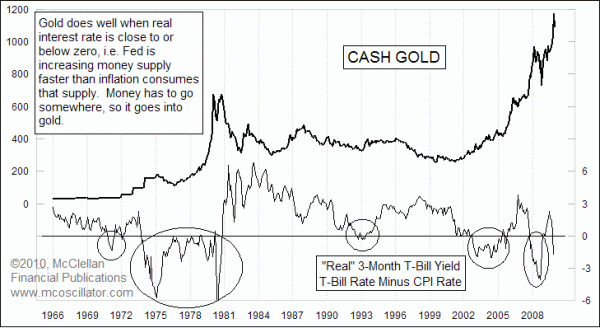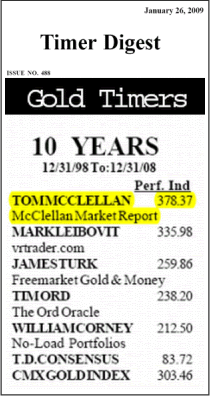The One Real Fundamental Factor Driving Gold Prices

Free Chart In Focus email
Delivered to you every week
The gold coin commercials that are becoming ubiquitous on radio and TV are full of lots of reasons why you should buy their product. Celebrity spokesmen tell us about gold's behavior in "bad economic times". They even allude to gold's supposed role as a "currency of last resort", if things ever get really bad.
Actually, if things really do get that bad, gold coins won't be worth much. The real currency of LAST resort will be canned food and shotgun shells.
What the gold coin commercials don't tell you is the one real fundamental factor that drives gold prices up and down. That factor is real interest rates.
The word "real" in this case refers to adjusting nominal interest rates for inflation. In this week's chart, the lower line shows the real 3-month T-Bill yield, adjusted for inflation using the 12-month rate of change in the CPI-U. When the line is above zero, it means that the T-Bill yield is above the inflation rate. That sort of condition tends to be a negative for gold prices.
The reason is that if an investor buys gold, he foregoes earning interest on the money he invests. The higher the interest rate, the more he misses out. So having high "real" rates means that owning gold costs a lot more in terms of missed opportunity. Conversely, low or even negative real rates make owning gold seem like a better idea.
The circles in the chart highlight instances of negative real rates. The little one at the far left end of the chart does not look like much, but it created enough pressure on the monetary system to push the US off the gold standard. The even bigger episode during the mid to late 1970s helped to fuel the huge gold bubble of that decade.
When Volcker took charge of the Fed, he finally got interest rates up high enough to kill the runaway inflation. That also killed the bubble in gold. By keeping real interest rates mostly positive through the 1980s and 1990s, the Fed helped to drive gold prices down to the mid-$200s by 2001.
That was when Greenspan lowered the Fed Funds rate down to 1% and kept it there for a long time, despite rising inflation and rises in other rates. Those negative real rates from 2002-05 helped fuel the kickoff of the current multi-year uptrend in gold.
At the far right end of the chart, we see that now real rates are back to negative again. Over the next few months, that negative real yield situation is likely to get even more extreme. The Fed shows little willingness now to abandon its target of "0 to 0.25%", and yet inflation is already evident to those willing to see it. Crude oil prices are up 120% from the February 2009 low, and other commodities are rising as well. That will push inflation up even higher, pushing the real rates even further into negative territory.
Until the Fed decides to raise short term rates above the inflation rate, it is a great environment for gold prices to zoom higher. How much higher depends on how long the Fed stays on the wrong side of the ball, and keeps real interest rates negative.
Tom McClellan
Editor, The McClellan Market Report
Nov 20, 2009 NDX A-D Oscillator |
Dec 04, 2009 How Gold Forms Tops |
Jan 29, 2010 Unusual Stochastic Makes Good Oscillator |